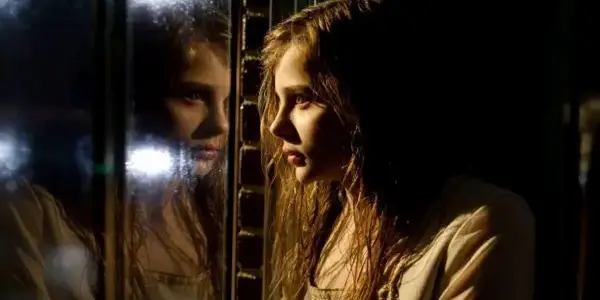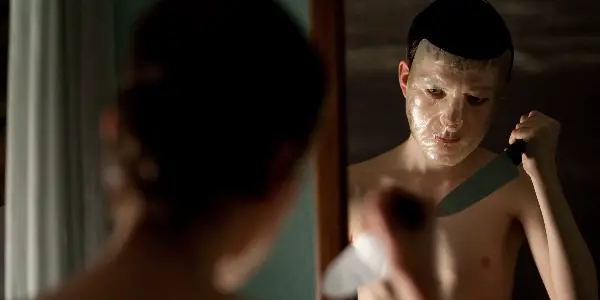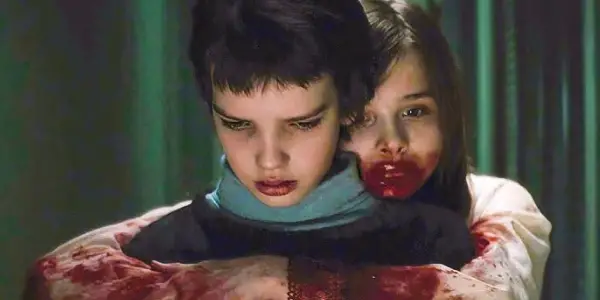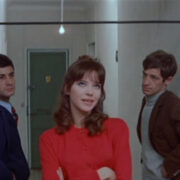Horrific Inquiry: LET ME IN (2010)

Stephanie Archer is 39 year old film fanatic living in…
Welcome back to the scariest, and at times goriest, column here at Film Inquiry: Horrific Inquiry. Twice a month, I will be tackling all things horror, bringing two films back into the spotlight to terrify and frighten once more. And occasionally looking at those that could have pushed the envelope further. Join us as we dive deep into the heart of horror, but warning, there will be spoilers.
There is a romanticism that lives within the horrific lore of the vampire. An immortal curse full of lust and desire within the heart of murder and darkness. And with the Valentine’s season upon us, only the vampire felt like a fitting horrific venture. There have been so many takes throughout the years, comedy, young adult, drama and horror, the lore an endless bloodline of creative avenues. Director Matt Reeves, he found his vampire cinematic tale in the heart of Swedish cinema, bringing to life an Americanized version of John Ajvide Lindqvist‘s Let The Right One In. Despite its critical acclaim at the time of its release, Let Me In would miss the mark on its viewers becoming one of the lowest-grossing films of 2010.
Having seen it shortly after its release, returning to the film carried a new weight of knowledge, both in horror and filmography. Since the film’s release, Matt Reeves has tackled another famous remake, bringing the Planet of the Apes to new heights and a new generation in brilliant cinematic fashion. And if that wasn’t enough to reshape a return to the filmmaker’s earlier work, his recent take with The Batman adds an even broader look at the continually growing works of Matt Reeves.
Eerie Opening
Let Me In begins with an eerie opening, the music subtle but lingering. As we read the title cards, audiences are given a time and a place, the film transitioning to a steady shot of the wilderness from above, emergency vehicles in the distance lighting the night. At first silent, their sirens slowly become audible. There is craftsmanship in this opening moment, the camera holding still, pensive and patient. The film will follow this tone to perfection, almost giving Let Me In the feeling of holding one’s breath.

As the camera moves into the ambulance, there are small glimpses of the chaos, the CB radio giving context. They are transporting a criminal suspect who has doused himself in acid. We never see the victim, nor a full image of the medics, the camera utilizing close-ups to obscure our view. Even as The Policeman (Elias Koteas) arrives at the hospital, the camera flirts with our ability to see the criminal, keeping him present but always blurred within the background. As it switches momentarily to the perspective of the man, Let Me In continues the blurred effect, the man’s vision going in and out of focus. As visuals are limited, the film once again leans into the sounds, rhythmic now rather than chaotic, with the beeps of the machines and the compression of the ventilator filling in the spaces.
As The Policeman leaves to answer a call, the man writes a message on a small pad – “I’m sorry Abby” – before the screams of his attending nurse finds he has jumped out the window to his death. As a speech of by Ronald Reagan speaks to the “capacity for transcending the moral evils of our past”, Let Me In takes on the feeling of an ominous darkness just on the periphery.
Creating an evil
From a criminal jumping out a window to the words of a president commenting on the legacy of evil within a nation, Let Me In settles on the simplicity and innocence of a young boy sitting on a playground. Having seen this years ago, I was surprised to see the young boy was Kodi Smit-McPhee, a different level of appreciation forming as I watched his performance here through the lens of The Power of the Dog. Quickly, Smit-McPhee wields both the meekness of Owen as well as his desire to be strong. Yet this desire leads to depictions of violence, the young boy wielding a knife in a mask and asking his reflection “Are you scared little girl”. There is an obvious violence to the act before us, though as we learn he is constantly bullied, it feels more like a reenactment of the violence he can not face beyond the safe space of his reflection.

Giving a brief nod to Rear Window, Owen utilizes his telescope to take in the other inhabitants of the complex. While sex and masculinity are the primary displays of those around him, it is the figures shrouded in shadows that catch his eye. As an old man and a young girl arrive in the darkness of night to move into the apartment next to him, Let Me In begins to build to ominous intrigue, both the audience and Owen taking in the young girl’s missing shoes as she walks barefoot in the snow. While it is introducing the central horror, which speaks to a legacy of evil, we are about to meet an even more devastating, and all too real, depiction of evil.
The film works through Owen’s abuse at the hands of his bullies in a dramatically accelerated fashion. Their first introduction begins as a spitball during the pledge of allegiance and grows into attempted murder. These bullies corner Owen in the bathroom, the locker room and the edge of a lake, ready to pounce on him the first chance they get. Calling him a “little girl”, Kenny exhibits a deep and growing hate for Owen with each interaction, with each glance in his direction. Dylan Minniette works well to harness this hate, but also a hidden pain that only appears occasionally, especially after viewers learn he is the victim of his own brother’s bullying. Rewatching the film, it is strange to watch Minniette inflict the pain he fights against years later in 13 Reasons Why, though the contrast of these roles over the years only further heightens the effectiveness of his performance here.
A Transference of Love and Lore
Let Me In works on the love within an evil. The Father (Richard Jenkins) is quiet and reserved, though constantly carrying a tired weight behind his eyes. As he sneaks out into the night, audiences come to understand the eternal love and devotion he has given to Abby (Chloë Grace Moretz) over the years. As he breaks into the back seat of a car and stows away, it is quickly understood his intention to harm the car’s driver. There is a savvy and smooth style to the way he calculates each movement, speaking to the perfection he has garnered over the past several decades. As he slowly sits up in the car, there is a deep understanding of the success of the horror elements Reeves brought to The Batman. As The Father quietly sits in wait behind the driver for his moment to strike, audiences will find themselves drawn back to the beginning of The Batman, The Riddler masked in a similar fashion waiting just as patiently in the shadows to attack.

As The Father drags his victim to the woods, stringing him up and bleeding him, there is a horror in the amount of bodies that have come before, pure white snow only adding to the feeling of hunter and his prey. Yet, as The Father collects the container of blood, he trips and sprains his ankle, losing all the blood in the process. There is despair in his face, giving the moment a heavy, yet unknown weight. The scene is vital for both the transition that is about to begin and the end that has now become inevitable. Yet, in the face of failure, The Father pushes forward, attempting later on in the film to execute his hunt for blood once more. As distressing the task has become for him, he never wavers, his love for Abby eternal. This is something he has vowed to do until his final breath.
Yet, where he is mortal, Abby is not and there is a sense that she knows his time is up. Shortly after arriving at the complex, Abby approaches Owen as he stabs a tree. As they begin to interact, she tells him “Just so you know, I can’t be your friend.” It is a quite nod to the fact that the only person she can be with is the one that is beyond a friend, a devout that will dedicate their life to her. As she spoke these words, Let Me In felt like a darker version of Fifty Shades or Twilight, the darkness pushing back against what it wants, those eventually giving into the desire. After feeding, one of the film’s few gore-infused moments, Abby continues to connect with Owen, the two beginning to form an attachment, Owen asking her to be his girlfriend. It is these initial moments that will make the viewer wonder if The Father failed in his attempt for blood as Abby was beginning to move to another “love”.

This belief is heightened in one of the film’s most poignant moments. As the Father is leaving for his first kill of the film, there is a shared moment between himself and Owen. As The Father is leaving, Owen is on the playground in the middle of the courtyard, their eyes meet and it is as though a fracture is created. The Father appears to lose Abby’s protection as she begins to move closer to Owen. Or it might be as simple as he subconsciously sees the next torchbearer, the need to remain undiscovered and unrelenting giving way. At this moment, there is a transference of position, and the start of the end of The Father is begun, Owen beginning to take on the power to not only protect Abby but to procure for her.
Conclusion
Let Me In works off these moments, growing the relationship of Owen and Abby while moving forward the lore of the vampire. As audiences come to understand, the man from the beginning is The Father. Having failed to acquire more blood and on the verge of discovery, he douses himself in acid to save Abby. The film works us through the beginning again but with new eyes and new understanding. Finally ready to reveal the horrific nature of The Father following the acid, we also become witnesses to his final act of love for Abby. As she visits him in the hospital, there is a quiet moment shared between them before The Father extends his neck to Abby for her to feed. He may have failed in acquiring the blood, but not in his love for her. As he falls to his death, he has fulfilled his promise to be devoted to her and keep her safe.
With The Father’s time ended, the world begins to close in on Abby threatening her very existence. As she continues to grow closer to Owen, Let Me In continues to hone in on her need for someone else. As she empowers Owen to stand up for himself, his absent parents and loneliness draw him even closer to Abby driving him to the moment where he must decide what life he wants. After discovery by The Policeman and the brutal attack by Abby, Owen begins to make his final transition to her, closing the door as The Policeman reaches out for his help. As Abby wraps her bloodied body around Owen and explains she needs to leave, Owen stays behind watching her slip away into the night the same as she had arrived.
As the film heads to its conclusion, it is the understanding of the balance of love that keeps Owen from following Abby. While he had closed the door on The Policeman proving his devotion, up until this point, Abby had not yet given the same in return. Enter the film’s final battle of evil against evil.
As Owen returns to school, Kenny, his brother and lackeys corner Owen in the locker room dragging him out to the pool. Everyone has fled, the teacher is locked outside after responding to a dumpster fire. With no one to protect him, he is left to the mercy of his bullies. As he is told to hold his breath under water for three minutes or have his eyes cut out, the darkness of evil descends as we realize Kenny’s brother has no intention of letting him back up. The camera captures both Kenny and his friends making the same realization, the uneasiness of their actions settling in. As the camera brings us back to Owen, it seems evil has prevailed. That is until Kenny’s brother’s head falls into the water, dismembered from its body. Blood fills the pool wrapping around Owen. Like Owen, we do not see the violence directly, rather the bloody aftermath. Even Abby is hidden from view, only her bare feet visible following the attack.
Let Me In works through its entirety to showcase both a balance in love and sacrifice. Following Abby’s attack on his bullies, Owen becomes completely devoted to Abby, each having provided the other protection and support. As Owen makes his way on the train to their new location, he keeps the trunk where Abby hides close to him. With the final moments of Let Me In closing out the film, Abby and Owen utilize their learned morse code, Abby knocking “Hi” with Owen responding “XO”, their love and devotion satisfied to the final breath.
Does content like this matter to you?
Become a Member and support film journalism. Unlock access to all of Film Inquiry`s great articles. Join a community of like-minded readers who are passionate about cinema - get access to our private members Network, give back to independent filmmakers, and more.













